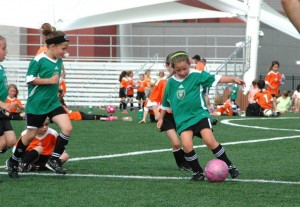This article comes from our conditioning experts at Soccer FIT Academy. Our club is fortunate to work with Scott Moody and his trainers at Soccer FIT. This post caught my eye because we are currently working with Scott to set up Speed and Agility goals for the wide range in age groups that we deal with. We have more than 6,000 players in the club and the level goes from elite National League teams down to recreational.
Many aspects of sport are progressed as players develop, but speed and agility training is often not one of these things. In basketball and soccer we start off playing small sided games at 6- or 7- years old (3v3) and then progress to 4v4, 5v5 and in soccer 6v6, 8v8 and finally 11v11. We have rules and restrictions that change (no pressure in the back court, all man-to-man, no goalies, etc.). We even change the field/court and goal sizes/heights. At the early ages we fo cus on simple technical skills and technical movement (how players position themselves on the field/court – man-to-man or zone, formations, etc.).
cus on simple technical skills and technical movement (how players position themselves on the field/court – man-to-man or zone, formations, etc.).
On the physical side, we focus on body weight movement first, then technical lifting with light weights and finally progress up to percentage based targets of 1RM. We build aerobic and anaerobic fitness and have progressions and tapers built into to peak these aspects at appropriate times.
“But with speed drills (and more often agility drills) we see the same patterns reped out with our players over the entire course of their career”
Here’s an example…I watch soccer players (high school, college and professional) warm up with speed/agility drills over and around cones. The drills are as basic as those I would run with my 8 year old daughter. I see professional players using ladder patterns in their programs that they have been using since they first began training. I see the same speed form drills (based on a track and field approach) used at every level (ankle hops, marches, skips, bounds, etc.). Now before you get the wrong idea, I understand that some of these things are important, and the rhythm and technical work needs to be maintained at every level. But specifically in the U10-U14 age groups (ages where developmental systems are arguably most important), why do we do the same things they did at 8 and continue to do a 28?
One study I recently read (1) monitored elite male basketball players in this age group over time, and noticed that speed (20 yd dash) improved as players age (gaining size strength and power). This study also used three different types of agility tests, and in the younger age groups, many players scored high on one test but low in another. In the older age groups, players who scored high in one test ultimately scored high in all tests and vice versa. So what does this mean?
In the younger ages we should be focusing on developing a very broad foundation, less structure, more variety and randomization in our agility patterns. We should start with the primary movements associated with various means of acceleration, change of direction, change of direction at varying angles and change of pace. Then by the time the players have mastered each of these aspects, we should increase our expectations or change the environment to include reactive measures, visual scanning, and situational elements. Finally, as they reach a point of mastery, we should include a technical element (as they should also be technically proficient in basic skills (dribbling, passing, shooting, etc.). This progressive, integrated approach can create a developmental structure that allows for improvements in both speed/agility as well as on-field/on-court application of these skills.
Simply put, start with the movement/rhythm, then change the tempo, direction/distance and reactive target, and finally focus in on how these movements relate to game simulated execution. I would love to hear your thoughts or resources that you use or find beneficial on this topic…
- Jakovljevic, S, M Karalejic, et al. “Speed and Agility of 12 and 14 Year Old Elite Male Basketball Players.” Journal of Strength and Conditioning Research. 26.9 (2012): 2453. Print.



